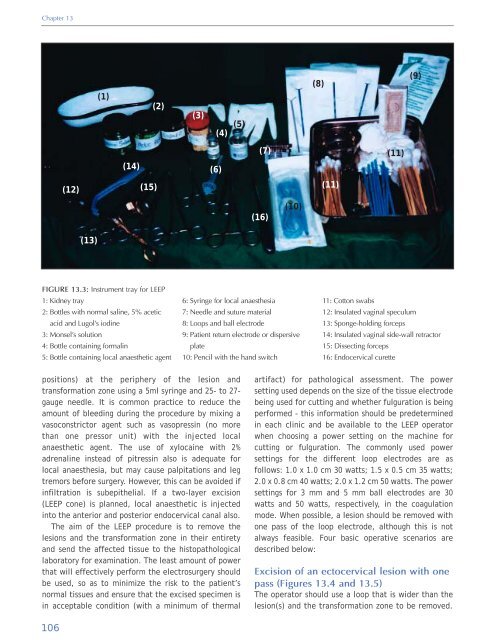Colposcopy and Treatment of Cervical Intraepithelial Neoplasia - RHO
Colposcopy and Treatment of Cervical Intraepithelial Neoplasia - RHO
Colposcopy and Treatment of Cervical Intraepithelial Neoplasia - RHO
Create successful ePaper yourself
Turn your PDF publications into a flip-book with our unique Google optimized e-Paper software.
Chapter 13<br />
(1)<br />
(2)<br />
(3)<br />
(4)<br />
(5)<br />
(8)<br />
(9)<br />
(14)<br />
(6)<br />
(7)<br />
(11)<br />
(12)<br />
(15)<br />
(11)<br />
(16)<br />
(10)<br />
(13)<br />
FIGURE 13.3: Instrument tray for LEEP<br />
1: Kidney tray<br />
2: Bottles with normal saline, 5% acetic<br />
acid <strong>and</strong> Lugol's iodine<br />
3: Monsel's solution<br />
4: Bottle containing formalin<br />
5: Bottle containing local anaesthetic agent<br />
6: Syringe for local anaesthesia<br />
7: Needle <strong>and</strong> suture material<br />
8: Loops <strong>and</strong> ball electrode<br />
9: Patient return electrode or dispersive<br />
plate<br />
10: Pencil with the h<strong>and</strong> switch<br />
11: Cotton swabs<br />
12: Insulated vaginal speculum<br />
13: Sponge-holding forceps<br />
14: Insulated vaginal side-wall retractor<br />
15: Dissecting forceps<br />
16: Endocervical curette<br />
positions) at the periphery <strong>of</strong> the lesion <strong>and</strong><br />
transformation zone using a 5ml syringe <strong>and</strong> 25- to 27-<br />
gauge needle. It is common practice to reduce the<br />
amount <strong>of</strong> bleeding during the procedure by mixing a<br />
vasoconstrictor agent such as vasopressin (no more<br />
than one pressor unit) with the injected local<br />
anaesthetic agent. The use <strong>of</strong> xylocaine with 2%<br />
adrenaline instead <strong>of</strong> pitressin also is adequate for<br />
local anaesthesia, but may cause palpitations <strong>and</strong> leg<br />
tremors before surgery. However, this can be avoided if<br />
infiltration is subepithelial. If a two-layer excision<br />
(LEEP cone) is planned, local anaesthetic is injected<br />
into the anterior <strong>and</strong> posterior endocervical canal also.<br />
The aim <strong>of</strong> the LEEP procedure is to remove the<br />
lesions <strong>and</strong> the transformation zone in their entirety<br />
<strong>and</strong> send the affected tissue to the histopathological<br />
laboratory for examination. The least amount <strong>of</strong> power<br />
that will effectively perform the electrosurgery should<br />
be used, so as to minimize the risk to the patient’s<br />
normal tissues <strong>and</strong> ensure that the excised specimen is<br />
in acceptable condition (with a minimum <strong>of</strong> thermal<br />
artifact) for pathological assessment. The power<br />
setting used depends on the size <strong>of</strong> the tissue electrode<br />
being used for cutting <strong>and</strong> whether fulguration is being<br />
performed - this information should be predetermined<br />
in each clinic <strong>and</strong> be available to the LEEP operator<br />
when choosing a power setting on the machine for<br />
cutting or fulguration. The commonly used power<br />
settings for the different loop electrodes are as<br />
follows: 1.0 x 1.0 cm 30 watts; 1.5 x 0.5 cm 35 watts;<br />
2.0 x 0.8 cm 40 watts; 2.0 x 1.2 cm 50 watts. The power<br />
settings for 3 mm <strong>and</strong> 5 mm ball electrodes are 30<br />
watts <strong>and</strong> 50 watts, respectively, in the coagulation<br />
mode. When possible, a lesion should be removed with<br />
one pass <strong>of</strong> the loop electrode, although this is not<br />
always feasible. Four basic operative scenarios are<br />
described below:<br />
Excision <strong>of</strong> an ectocervical lesion with one<br />
pass (Figures 13.4 <strong>and</strong> 13.5)<br />
The operator should use a loop that is wider than the<br />
lesion(s) <strong>and</strong> the transformation zone to be removed.<br />
106
















